Last updated on November 9th, 2024
Featured image: Travel Switzerland by train for a sustainable adventure | Photo by Switzerland Tourism
How Switzerland and Trafalgar Travel are making it easier to travel sustainably
by Carolyn Ray
It’s a startlingly sunny day in Zermatt, Switzerland and the view of the Matterhorn is picture-perfect. Walking down the main street, I’m lost in my memories, trying to remember Zermatt as it was 40 years ago. Then, I was an 18-year-old high school student, living in a country where I didn’t speak the language and felt awkward and out of place. That year away from my friends and family was hard, but it was also a year of transformation, from teenager to adult. Switzerland is a place I love dearly, and my heart feels full being back in my adopted home.
Zermatt is just one of the stops on Contrasts of Switzerland, a “Swisstainable” Train tour that I’ve been invited to by Trafalgar Travel. My journey starts in Zurich and crosses the entire country by train. Over eight days, I travel along some of Switzerland’s most iconic train routes: the Glacier Express, Bernina Express, and the GoldenPass Train Line. Stops include St. Moritz, Zermatt, Lausanne, Interlaken, Geneva and Lucerne, where I spend another four days on my own. (Read more about Lucerne here). Not only can I revel in my memories, but I am here to learn about the effects of climate change and understand what we, as travellers, can do to help.

The Matterhorn in Zermatt, Switzerland / Photo by Carolyn Ray
Switzerland wants to be the most sustainable country in the world
Switzerland has made a national commitment to be the most sustainable country in the world and become carbon neutral by 2050. In 2021, Switzerland launched its ‘Swisstainable’ program, a national certification for sustainability that includes gastronomy, accommodations, transportation, parks and more. Over 2,600 tourism businesses have now joined the Swisstainable programme, which has a three-tiered level of certification. (Read more about Swisstainable Travel here)
“With one of the most closely-knit rail networks in the world, leading recycling, and impressive air and water quality – Switzerland is well positioned to lead the way towards a sustainable future,” says Oliver Weibel, Director, Canada, Switzerland Tourism. “Taking sustainable forms of transport within Switzerland, such as the train, are one of the easiest ways that visitors can help slow the effects of climate change, along with choosing Swisstainable classified hotels, restaurants and various other Swisstainable service partners.”
One of those service partners is Trafalgar Travel, which transformed its existing Contrasts of Switzerland train trip into a “Swisstainable” accredited tour. According to Clare Haney, TTC’s Managing Director, it took six months to make their tour fully sustainable, involving hundreds of suppliers. Haney says that every part of the trip had to be pulled apart to ensure that every hotel, restaurant, and experience was accredited. Her aspiration is that other travel companies will follow their lead.
“When you’re travelling to Switzerland, you can identify ‘Swisstainable’ businesses because they also get an easily seen accreditation through Swiss Tourism,” Haney says. “I hope that our guests walk away with a greater understanding of how travelling responsibly can have a positive impact on the communities in which they travel through.”
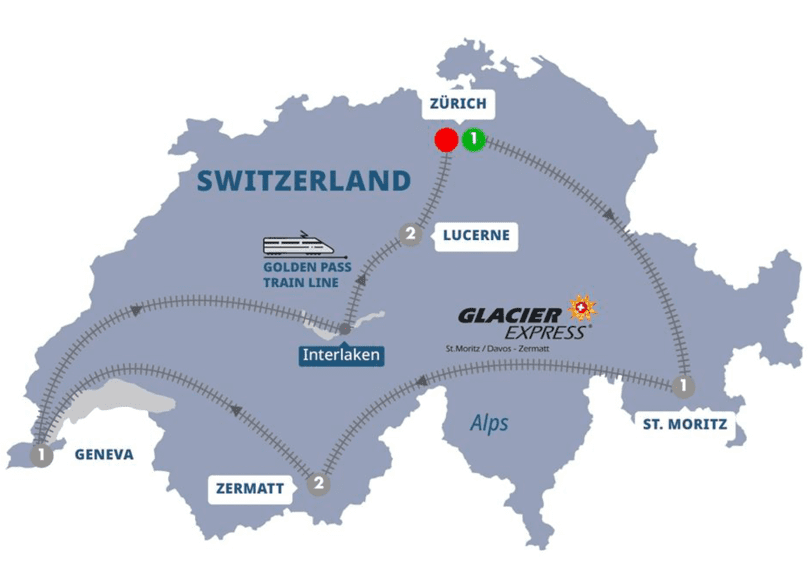
The route for the Contrasts of Switzerland Tour / Photo by Trafalgar Tours

Contrasts of Switzerland is a certified Swisstainsble tour / Photo by Trafalgar Tours
Witnessing climate change first hand
On my nine-day train trip across Switzerland, I am shocked to see dramatic changes to the glaciers with my own eyes. Since I lived in Switzerland as a student in the 1980s, it’s estimated that 1,000 glaciers have melted. Glaciers are the source of our fresh water through lakes, rivers and oceans. They also act like mirrors, reflecting excess heat back into space to keep our planet cooler.
According to Matthias Huss, the head of the Swiss Glacier Monitoring Network (GLAMOS), two-thirds of the ice in the European Alps will no longer exist by the end of the century. (To see archival photographs of glaciers receding, click here.)
“If there is no climate mitigation, we are going to lose all the glaciers in the Alps by 2100,” Matthias Huss, the head of the Swiss Glacier Monitoring Network (GLAMOS), told the BBC. The water for most of Europe’s rivers – the Rhone, Danube, and Rhine – comes from the glaciers in Switzerland. Switzerland holds about 6% of the continent’s freshwater reserves and is considered the ‘water castle’ of Europe.”
Three iconic journeys to travel Switzerland by train
When it comes to breathtakingly beautiful countries like Switzerland, travelling by train affords the flexibility to walk around, connect with others and enjoy the ride. With the panoramic windows, everyone has a window seat, so that you can see each pristine lake, mountain, and vista. Travel is even better by train — it’s easy, stress-free and sustainable.
1. The Bernina Express
With 55 tunnels and 196 bridges, the UNESCO Bernina Express is one of the most spectacular ways to see the Alps, crossing the 65-metre-high Landwasser Viaduct, the Montebello curve with a view of the Bernina massif.
Unfortunately, there is a landslide the day before, so we’re not able to take the train, although our bus journey travels the same route. Ellen, our guide, points out the receding outline of the Morteratsch glacier, (or she-devil), which supplies this area with water. It’s this glacier that allows the ski resorts to make snow and generate hydroelectric power for electricity. Amazingly, there is red sand covering the Alps, blown all the way from the Sahara Desert.
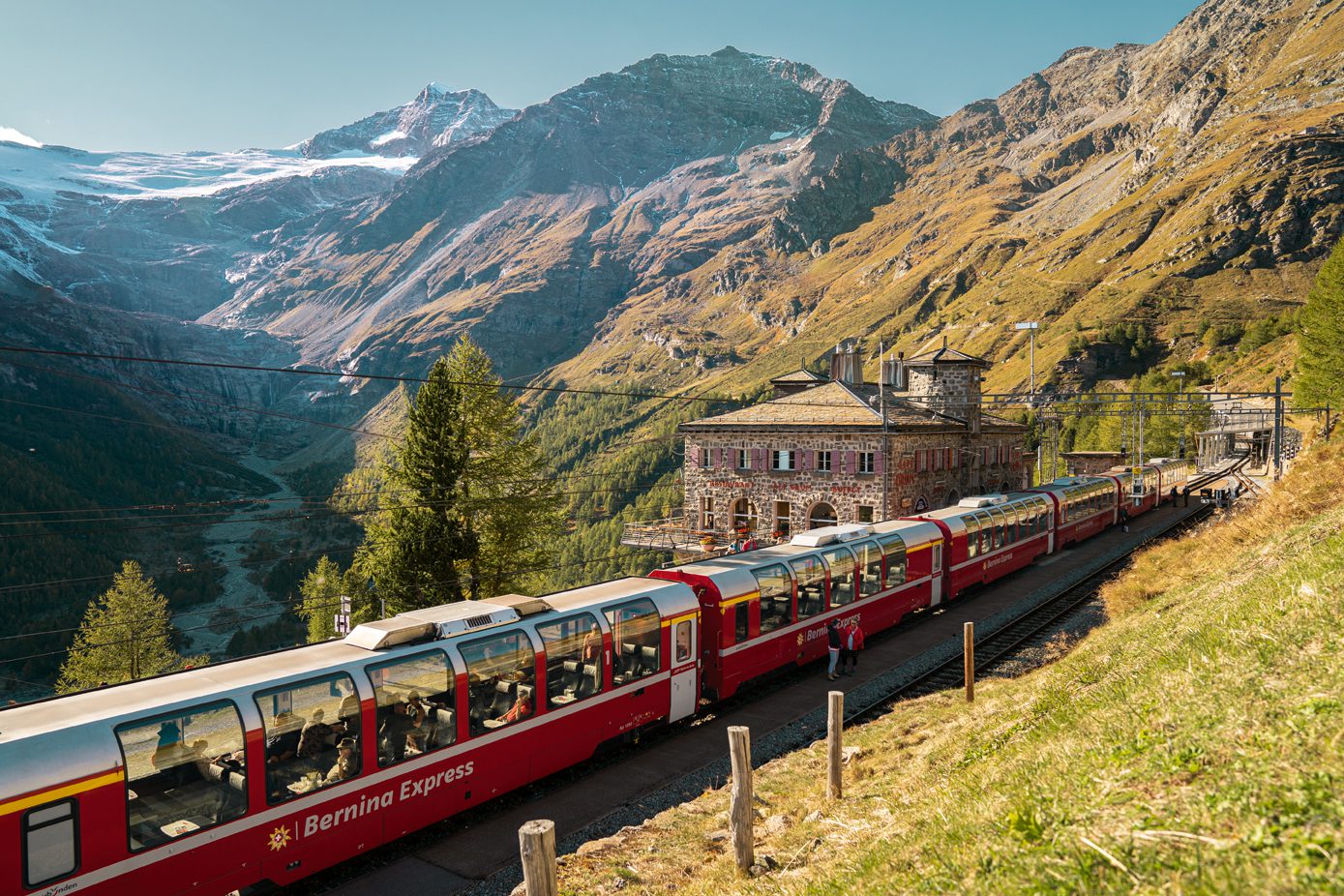
2. The Glacier Express
The Glacier Express is world famous for its stunning views and bridges and connects the mountain resorts of Zermatt and St. Moritz. It’s the slowest express train experience in the world, winding through remote valleys, sheer rock faces, over the Landwasser Viaduct and the Rhine Gorge, the ‘Grand Canyon’ of Switzerland. With 291 bridges and 91 tunnels, this is the experience I’ve dreamed of, with panorama windows, curvy tracks and views that literally take your breath away, like the Oberlap Pass, 2033 metres above sea level. Get tickets here.
In Zermatt, it’s easy to see evidence of change from the Matterhorn Glacier Paradise gondola station, the highest cable car station in Europe. Gliding past jagged peaks past snowy tree-topped valleys, the gondola rises to 3,883 metres (12,739 feet). My guide, Ellen Potters, points out the receding glacier near the top of the mountain, where there is rock, instead of snow and ice. A lot has changed since my last visit here 40 years ago.
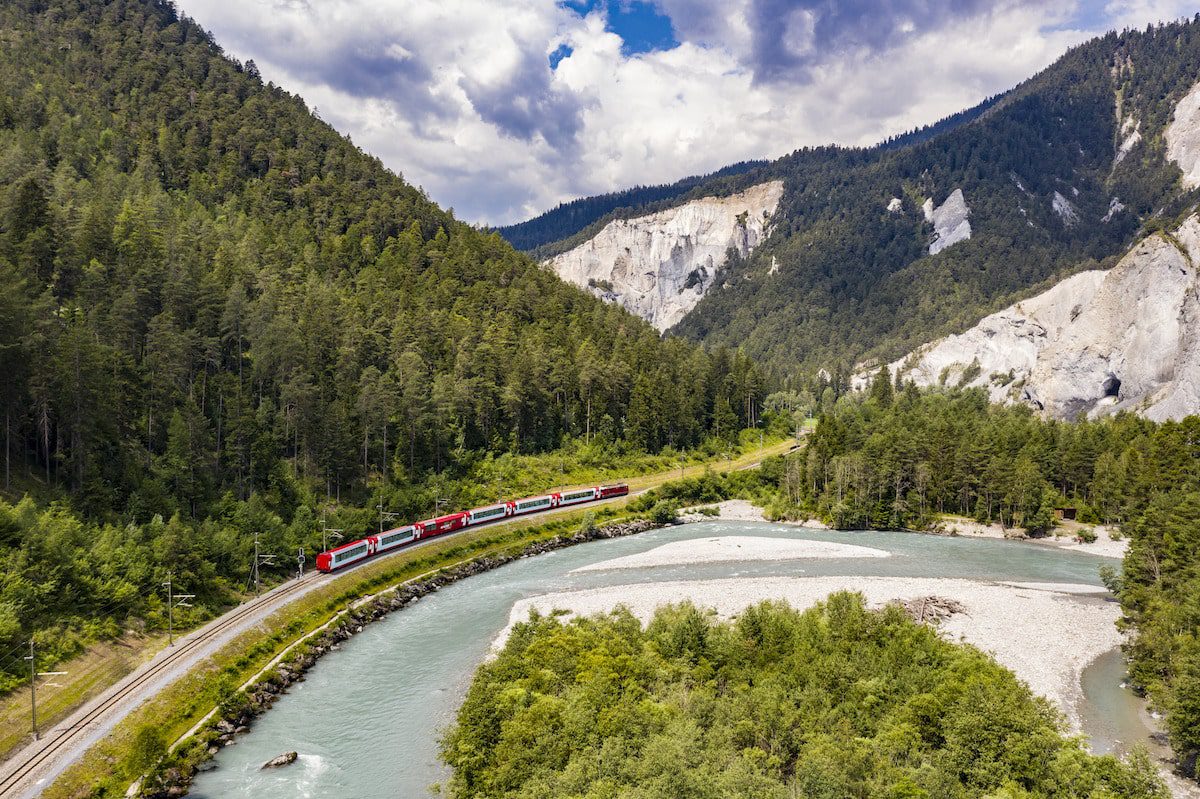
The Glacier Express travelling through the Rhine Gorge / Photo by Switzerland Tourism
3. The Golden Pass Train Line
The Golden Pass Train Line travels through Montreux, Interlaken and Lucerne. There are three trains: the GoldenPass Panoramic, the GoldenPass Belle Époque, and the luxurious GoldenPass Express. The GoldenPass Express is unique worldwide as it switches from the metric track (between Montreaux and Zweisimmen) to the normal track (between Zweisimmen and Interlaken) in a few seconds. This allows passengers to stay on the same train throughout the entire journey.
Trafalgar builds a local Make Travel Matter™ experience into all of its trips. In Geneva, we visit La Ferme Enchantee, where owner Laurence Duez-Pittaet shows improvements being made to her third-generation farm to improve land regeneration and bird houses to attract an endangered bird, the hoopoe. There’s also Tanguy, the head beekeeper from Apidae, a local organization that raises awareness about the decline of the bee population due to climate change.
As we leave Lausanne, the views of Lake Lucerne, Lake Sarnen, Lake Lungern and Lake Brienz have all of us running from one window to the next, as we zig zag up the mountain. The route, which includes Gstaad and Interlaken, is idyllic, with cows grazing in pastures, small log houses, bright yellow tulips, and the smell of fresh grass. There’s a Swiss flag outside every house and perfectly manicured lawns.
In Interlaken, I walk over to the park and gaze at the Aletsch Glacier, the largest glacier in the Alps (in Valais), which has ice 800 metres (2,624 feet) thick in parts. Without a dramatic reduction in greenhouse gases, glacier experts warn that this glacier could disappear within a generation.
Our last stop in Lucerne
Our train journey ends in Lucerne, with its two covered bridges and medieval towers. We take a day trip up one of Switzerland’s oldest mountain railways to Mount Stanserhorn, where the revolving restaurant 6,300 feet up operates on solar energy. The journey up on the 130-year old vintage Cabio funicular, which dates back to 1893, operates with two cable cars on the same system. As one comes down, it produces enough energy to pull the other cable car up. Instead of a coach back to Lucerne, we enjoy a leisurely solar powered boat cruise on Lake Lucerne. Even our hotel, the Radisson Blu, aims to be net zero by 2050.
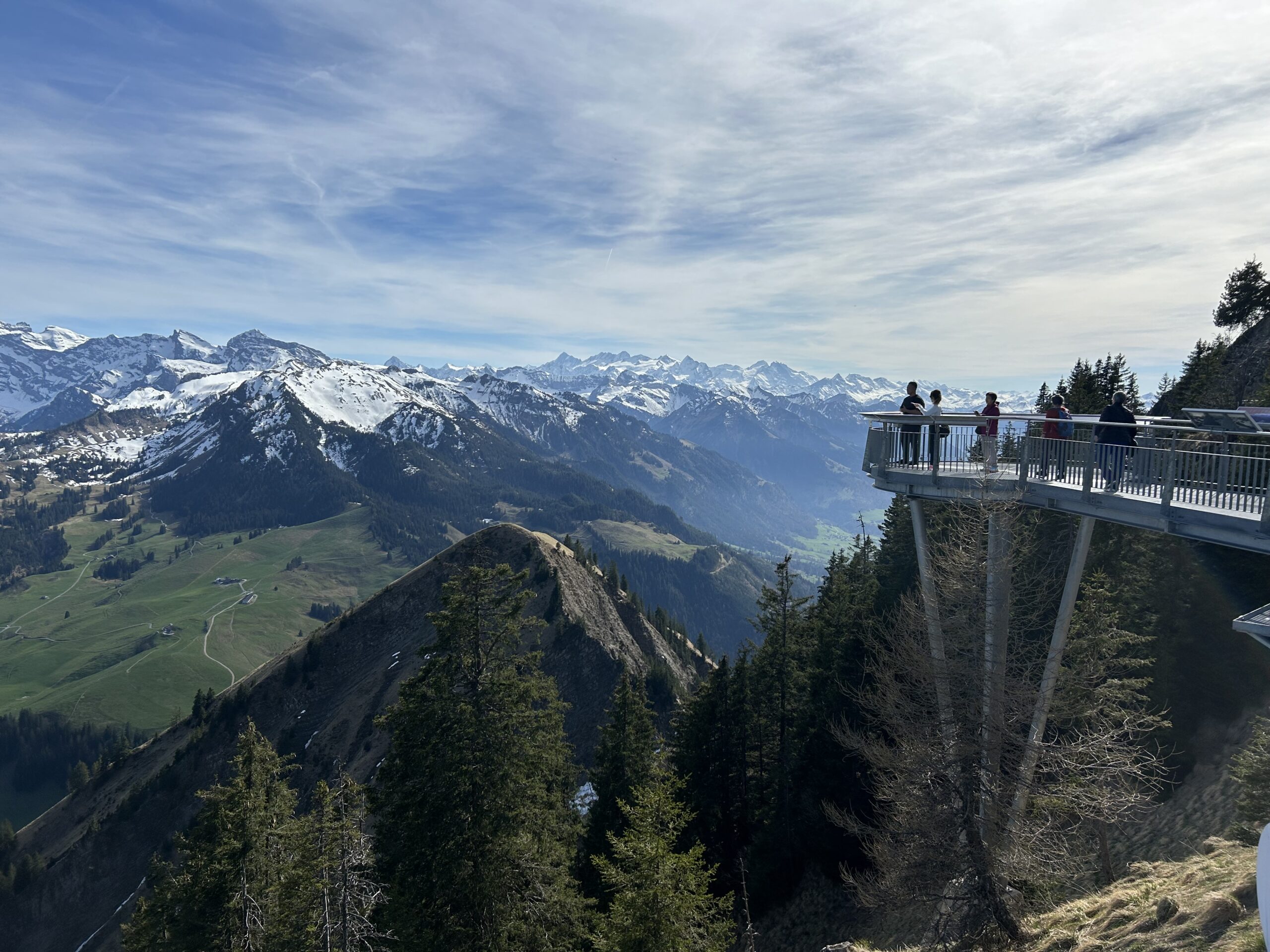
What’s next: travel with purpose
On this trip, I’ve seen tremendous changes in Switzerland that have happened just in my lifetime. Simply learning that the glaciers in Switzerland provide the water for the rivers of Europe was surprising to me. Just like the red sand I witnessed from the Sahara Desert on the Alps, it’s a reminder that we are all connected.
As travellers, we have the power to choose countries that prioritize sustainability as defined by the United Nation Sustainable Development Goals (SDGs). Having a certification backed by an entire country, like ‘Swisstainable,’ can help us make better choices, but we still need to ask questions and dig below the surface to understand environmental certification programs, which can often be misleading. We can also seek out companies that are measuring their impact and being transparent about results, such as the Travel Corporation, which just released its 2023 Annual Impact Report. Sustainable travel shouldn’t be hard, challenging or expensive, nor should the burden rest on travellers’ shoulders. It should be easy for all of us to participate purposefully in our shared future and do our part.
Tips for train travel
- Wear comfortable clothing
- Practice good etiquette: Don’t put your feet on the seats
- Trains run on time, so be early
- Pack light, as there are often scheduling changes, and bring Air Tags just in case
- Keep your passport with you, don’t leave items on the train and don’t leave things unattended
- Coaches marked ‘1’ are for first-class passengers, ‘2’ for the rest
- Trains operate on a trust system. You can board without showing your ticket to anyone, but it will be checked on the train
- Use a Swiss Rail Pass which you can keep on your phone (Download the SBB app here)
- Be ready to get off before your stop, and be careful getting on and off trains
- Use PeakFinder to identify mountain peaks

A solo ride on the gondola in Zermatt / Photo by Carolyn Ray
Five ways to travel sustainably
1. Look for trips that integrate sustainability practices. Trafalgar Tours’ Contrasts of Switzerland runs every week from April to September. Learn more here.
2. Look at the sustainability practices of your airline. Swiss Air (part of the Star Alliance) now flies direct from Toronto and Montreal to Zurich. The company plans to halve its 2019 net CO2 emissions by 2030 and make its business and operations entirely carbon-neutral by 2050, particularly by promoting the use of sustainable aviation fuels. Learn more here.
3. When travelling in Switzerland, look for the Swisstainable certification on hotels, restaurants, transportation and more. Learn more on Switzerland’s Swisstainable website.
4. Pack light on the train. This also helps you move quickly if there are schedule changes or need to take the stairs. I use a small carry-on bag, packing cubes and a 25L Gregory backpack. I always bring a headlamp, rubber door stopper, portable charger, extra phone and electrical adapter. For a trip in April, bring casual, comfortable clothing and layers for warm and cool weather. I packed a puffy jacket, a few long-sleeved shirts, one warm sweater, a puffy vest, sneakers, merino socks and a scarf.
5. Get a Swiss Rail Pass and download the SBB app. This makes it easy to travel Switzerland by train. Not only does this give you access to trains, buses and ferries, but it also gives you free entry to museums in Switzerland. Learn more here.
Disclaimer: On this trip, I was a guest of Trafalgar Travel, one of our women-friendly partners in our Women’s Travel Directory. The opinions expressed in this article are my own and were not reviewed by Trafalgar prior to publication.
More Sustainable Travel to Inspire You
Swimming with Whale Sharks in Mexico’s Galapagos: Adventures in La Paz, Baja California Sur
A once-in-a-lifetime experience swimming with whale sharks in La Paz, Mexico, reminds us to trust ourselves and the universe.
15 Stunning Train Trips to Inspire Your Travels in 2025
These train trips across Europe, Asia, Africa and Canada remind us that the journey can be more memorable than the destination.
Travel with Purpose: Volunteering at a Turtle Conservation Project in Costa Rica Makes My Dream Real
As a volunteer on a turtle conservation project in Costa Rica with Conservation VIP, I fulfilled a long-held dream to help baby turtles.

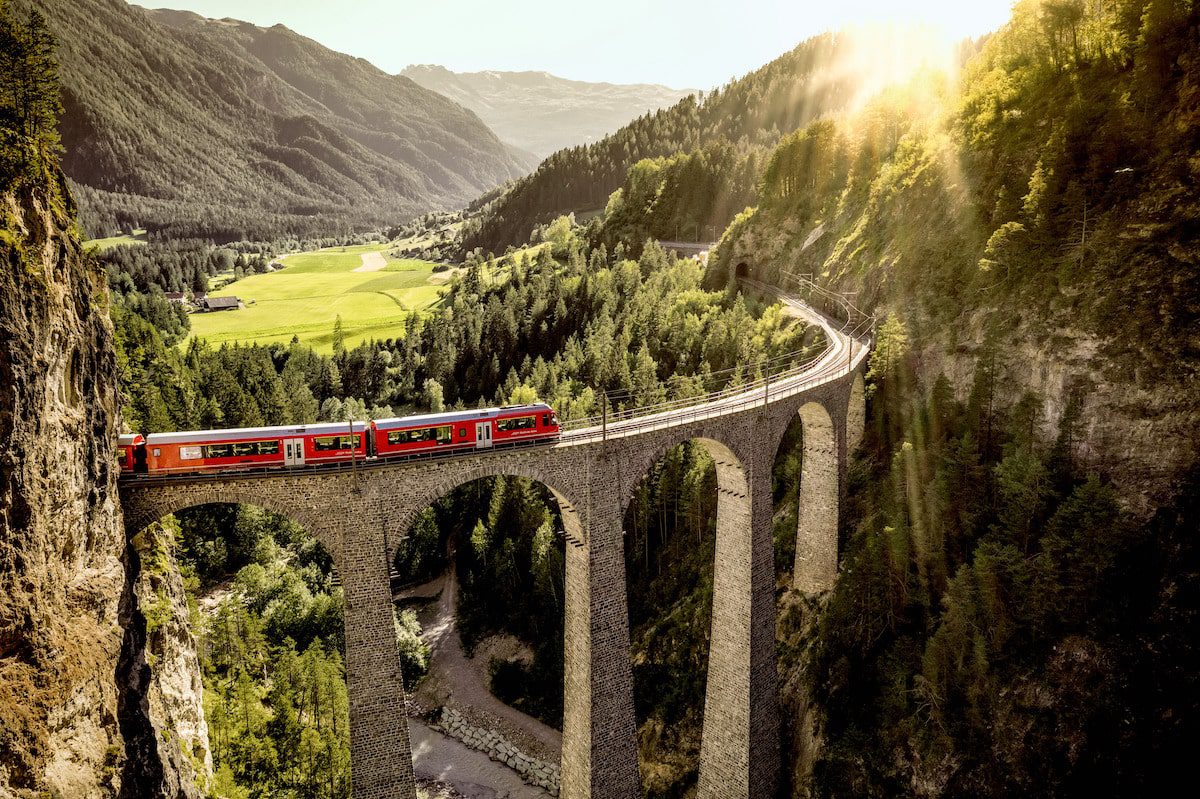




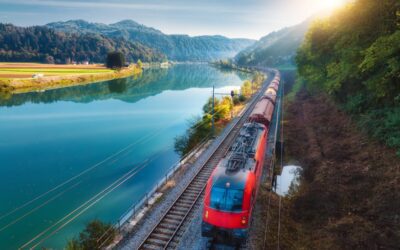
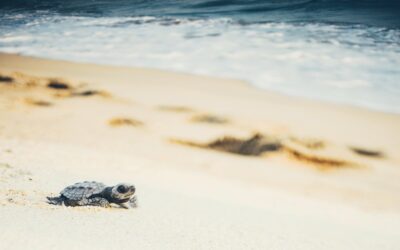
0 Comments
We always strive to use real photos from our own adventures, provided by the guest writer or from our personal travels. However, in some cases, due to photo quality, we must use stock photography. If you have any questions about the photography please let us know.
Disclaimer: We are so happy that you are checking out this page right now! We only recommend things that are suggested by our community, or through our own experience, that we believe will be helpful and practical for you. Some of our pages contain links, which means we’re part of an affiliate program for the product being mentioned. Should you decide to purchase a product using a link from on our site, JourneyWoman may earn a small commission from the retailer, which helps us maintain our beautiful website. JourneyWoman is an Amazon Associate and earns from qualifying purchases. Thank you!
We want to hear what you think about this article, and we welcome any updates or changes to improve it. You can comment below, or send an email to us at [email protected].